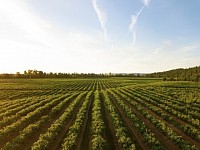Sarbagya's Bounty: Revolutionizing Agriculture with High-Quality Seeds
In the ever-evolving landscape of agriculture, the importance of high-quality seeds cannot be overstated. These tiny, potent vessels hold the promise of bountiful harvests, offering farmers the potential to transform their fields and livelihoods. Among the myriad of options available to farmers, Sarbagya stands out as a beacon of innovation and excellence, revolutionizing agriculture with its unparalleled selection of top-tier seeds.
Sarbagya, a leading name in the agricultural industry, has long been synonymous with quality, reliability, and innovation. With a commitment to empowering farmers and enhancing agricultural practices, Sarbagya has carved a niche for itself as a trusted provider of high-quality seeds that drive productivity, sustainability, and profitability.
At the heart of Sarbagya's mission is a dedication to research and development, continually striving to push the boundaries of seed technology and genetics. Through rigorous testing, experimentation, and collaboration with experts in the field, Sarbagya consistently delivers seeds that are tailored to meet the unique needs and challenges faced by farmers worldwide.
One of the key pillars of Sarbagya's success lies in its extensive selection of seeds, encompassing a wide range of crops and varieties. Whether it's staple crops like rice, wheat, and maize, or specialty crops such as fruits, vegetables, and pulses, Sarbagya offers a comprehensive array of options to suit every farming need.
What sets Sarbagya apart from its competitors is its unwavering commitment to quality control. From the moment seeds are sourced to the final product reaching the hands of farmers/sarbagya.simdif.com/page-13876525.html, Sarbagya employs stringent quality assurance measures to ensure consistency, purity, and viability. Each batch of seeds undergoes rigorous testing for germination rates, disease resistance, and genetic purity, guaranteeing that farmers receive seeds of the highest standard.
In addition to quality, Sarbagya places a strong emphasis on innovation, constantly seeking out new technologies and techniques to improve seed performance and adaptability. Whether it's developing drought-tolerant varieties, enhancing pest and disease resistance, or optimizing yield potential, Sarbagya is at the forefront of seed innovation, driving agricultural progress and sustainability.
But Sarbagya's impact extends beyond just providing seeds. Through its extensive network of partnerships and collaborations, Sarbagya works closely with farmers, agricultural experts, and organizations to promote best practices, knowledge sharing, and capacity building. By empowering farmers with the tools, resources, and know-how they need to succeed, Sarbagya is fostering a culture of agricultural excellence and prosperity.
In recent years, the importance of high-quality seeds has become increasingly evident in the face of mounting challenges such as climate change, resource scarcity, and food security concerns. As farmers grapple with unpredictable weather patterns, soil degradation, and evolving pest and disease pressures, the need for resilient, adaptive seeds has never been greater. In this regard, Sarbagya's commitment to innovation and sustainability is more vital than ever, offering farmers a lifeline in an increasingly uncertain world.
Looking ahead, Sarbagya remains steadfast in its mission to revolutionize agriculture and empower farmers worldwide. With a relentless pursuit of excellence, a passion for innovation, and a commitment to sustainability, Sarbagya is poised to continue leading the way in seed technology and agricultural advancement for years to come.
In conclusion, Sarbagya's bounty of high-quality seeds is not just a game-changer for farmers; it's a catalyst for transformation, driving progress, prosperity, and sustainability across the agricultural landscape. As we navigate the challenges of the 21st century, the seeds of change sown by Sarbagya offer hope, opportunity, and the promise of a brighter future for farmers and communities around the globe.
From Field to Table: Enhancing Crop Yield Through Effective Rotation Techniques
Imagine a world where every seed sown reaps the maximum harvest possible, where farmers achieve abundant yields year after year without compromising the health of their land. This is not merely a utopian dream but a tangible reality achievable through the practice of crop rotation. In this article, we embark on a journey through the fields, exploring the significance of crop rotation in enhancing agricultural productivity from planting to plate.
Understanding Crop Rotation:
At its core, crop rotation is a farming technique that involves the systematic alteration of crops grown on a particular piece of land over a defined period. Rather than planting the same crop repeatedly, farmers rotate through a sequence of different crops, each with unique nutrient requirements and growth characteristics. This method aims to break the cycle of pests and diseases, improve soil fertility, and maximize yields.
The Importance of Soil Health:
Healthy soil is the foundation of successful farming. It serves as a reservoir for nutrients, water, and essential microorganisms crucial for plant growth. Continuous monocropping depletes the soil of specific nutrients, leading to nutrient imbalances and decreased fertility over time. Crop rotation mitigates this by diversifying the nutrient demands of different crops, allowing the soil to replenish and regain its vitality.
Pest and Disease Management:
Monoculture fields are a haven for pests and diseases, as the continuous presence of the same crop provides a stable environment for their proliferation. Crop rotation disrupts this cycle by introducing crops that are less susceptible to prevalent pests and diseases or employing crops that naturally repel or inhibit the growth of harmful organisms. By alternating crops, farmers can reduce the need for chemical pesticides and fungicides, promoting a healthier ecosystem and minimizing environmental impact.
Optimizing Nutrient Utilization:
Different crops have varying nutrient requirements, with some depleting specific elements from the soil while others contribute to their replenishment. For instance, leguminous crops such as peas and beans have the remarkable ability to fix atmospheric nitrogen into the soil, enriching it for subsequent crops. Incorporating legumes into rotation cycles not only enhances soil fertility but also reduces the need for synthetic nitrogen fertilizers, thereby lowering input costs and environmental pollution.
Mitigating Soil Erosion:
Soil erosion poses a significant threat to agricultural sustainability, resulting in the loss of topsoil, reduced water retention capacity, and diminished crop productivity. Monocropping leaves the soil vulnerable to erosion, as the uniform canopy cover offers little protection against wind and water forces. Crop rotation mitigates erosion by varying the root structures and canopy characteristics of successive crops, stabilizing the soil and reducing erosion risk.
Improving Water Management:
Water scarcity is a growing concern in agriculture, exacerbated by climate change and inefficient irrigation practices. Crop rotation plays a role in water management by optimizing water usage through the selection of crops with different water requirements. By alternating between deep-rooted and shallow-rooted crops, farmers can utilize water resources more efficiently, minimizing runoff and maximizing infiltration, thereby enhancing water retention in the soil.
Enhancing Biodiversity:
Biodiversity is essential for the resilience and sustainability of ecosystems. Monoculture farming contributes to the loss of biodiversity by favoring a single species at the expense of others. Crop rotation promotes biodiversity by creating heterogeneous landscapes that support a wider array of plant and animal species. Diverse cropping systems provide habitats for beneficial insects, birds, and microorganisms, fostering ecological balance and reducing the reliance on external inputs for pest control.
Case Studies: Real-world Applications of Crop Rotation
To illustrate the practical benefits of crop rotation, let's examine a few case studies from around the world:
The Three-Sister Farming System: Originating from indigenous agricultural practices in North America, the Three Sisters—corn, beans, and squash—demonstrate the synergistic benefits of intercropping and crop rotation. Corn provides a structure for beans to climb, while beans fix nitrogen in the soil for corn and squash. Squash acts as a living mulch, suppressing weeds and conserving soil moisture. Together, these crops form a sustainable and productive system that has sustained indigenous communities for generations.
European Crop Rotations: Traditional European farming systems have long incorporated crop rotation as a cornerstone of agricultural sustainability. The Norfolk four-course rotation, developed in the 18th century, alternated between root crops, cereals, legumes, and fallow periods, replenishing soil nutrients and breaking pest cycles. Similarly, the Ley farming system in Germany involved alternating between crops and temporary grasslands, improving soil structure and fertility.
Conclusion:
Crop rotation is not merely a farming technique; it is a philosophy that embraces the interconnectedness of plants, soil, and ecosystems. By diversifying cropping systems, farmers can unlock the full potential of their land, achieving higher yields, reducing input costs, and promoting environmental stewardship. As we look to the future of agriculture, let us not overlook the wisdom of the past—crop rotation holds the key to sustainable farming practices that will feed generations to come.


